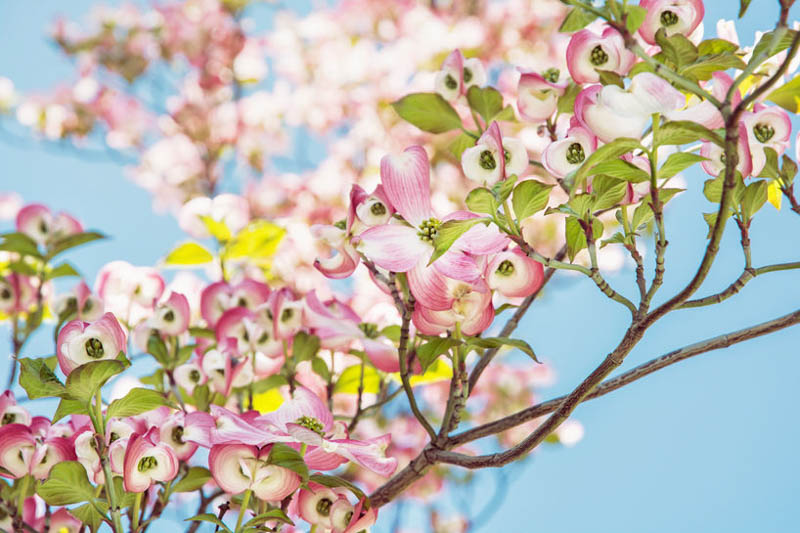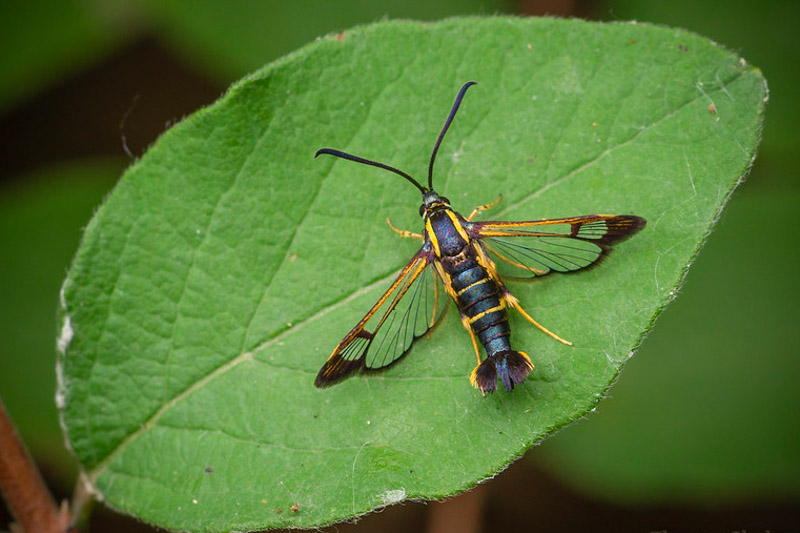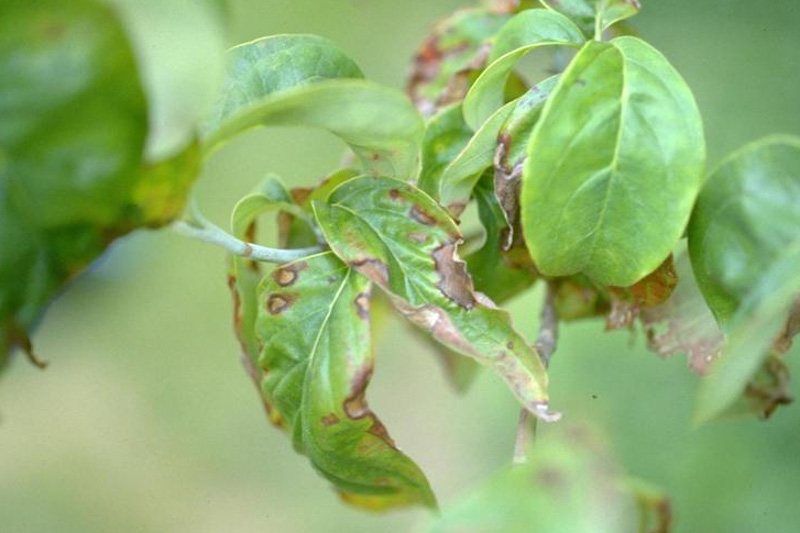Flowering Dogwood (Cornus florida), Kousa Dogwood (Cornus kousa), Pacific Dogwood (Cornus nuttallii), Cornelian Cherry Dogwood (Cornus mas), Pagoda Dogwood (Cornus alternifolia), Gray Dogwood (Cornus racemosa), Giant Dogwood (Cornus controversa)
Dogwood shrubs and trees serve multiple purposes in landscapes, from ornamental plantings to wildlife habitat.
The dogwood tree, belonging to the genus Cornus, is a versatile and widely loved ornamental plant native to various regions, including North America, Europe, and Asia. Species like Cornus florida and Cornus kousa are particularly popular in the United States for their distinctive white or pink blooms that herald the arrival of spring.
Dogwoods vary widely in form, from small trees to shrubs and even ground cover, making them ideal for smaller landscapes or as understory trees in larger wooded areas.
Their leaves are deciduous, and some species feature attractive autumn foliage in shades of red and purple.
The fruit of certain dogwood species is also edible, although not particularly tasty to humans, it is a food source for wildlife.
Known for their year-round appeal, which includes flowers in the spring, lush greenery in the summer, vibrant foliage in the fall, and textured bark in the winter, dogwoods are a staple in ornamental horticulture and are also significant in native ecosystems.
 Flowering Dogwood (Cornus Florida)
Flowering Dogwood (Cornus Florida)
Dogwoods are susceptible to a variety of pest issues that can affect their health and aesthetic appeal. The susceptibility of dogwood trees to pests varies by species and environmental conditions, but some general trends do exist.
Flowering Dogwood (Cornus florida) is often more susceptible to pests like the Dogwood Borer and Dogwood Twig Borer. Similarly, Pacific Dogwood (Cornus nuttallii) can be affected by various borers and gall midges.
Redosier Dogwood (Cornus sericea) and Tatarian dogwood (Cornus alba) are generally more resistant to common pests but aren’t entirely immune; they can still be affected by aphids and scale insects, for instance.
| Pest | Damage | Treatment |
| Dogwood Borer (Synanthedon scitula) | Wilted leaves, dying branches, sloughing or shedding of loose bark, holes in the bark. Weakened trees may die within a couple of seasons. Severity: High |
Insecticides. Avoid wounding, such as from lawnmowers. Proper cultural practices to maintain tree health. Cutting away dead or severely infested branches can limit the borer’s spread. |
| Dogwood Clubgall Midge | Abnormal swellings, or galls, on the leaves and stems of dogwood trees. Severity: Low |
Pruning and destroying affected twigs. |
| Dogwood Sawfly | The larvae feed voraciously on the leaves, often skeletonizing them by consuming the leaf tissue between the veins. In severe infestations, larvae can defoliate entire branches or even whole trees. Severity: Low to Moderate |
Manual removal, insecticidal soap. Encouraging birds and beneficial insects (ants, predatory wasps), can help naturally control sawfly populations. Keep the area around your trees clean and free of debris. |
| Dogwood Twig Borer (Oberea tripunctata) |
Affected branches may show signs of wilting or leaves turning yellow. Tips of branches may die back, and in extreme cases, entire branches may die. Severity: Low to Moderate |
Remove infested or damaged branches to prevent the larvae from spreading to the rest of the tree. Ensure your dogwood is planted in suitable soil and receives adequate water and nutrients. Chemicals can be effective but should be used as a last resort. |
| Flatheaded Appletree Borer | Damage is often most apparent at the base of the trunk but can occur higher up as well. Sunken, discolored patches on the bark or oozing sap may indicate an infestation. Severity: Moderate |
Ensure your tree is healthy, as stressed trees are more susceptible. Prevention of wounds, sun scald, or drought stress can greatly reduce borer attacks. Tree wraps, surface deterrents, whitewashing, physical removal. Insecticides when eggs are being laid and hatching. |
| Scale Insects | Symptoms include yellowing leaves, reduced growth, and a sticky substance known as “honeydew,” which may also attract ants and sooty mold. In severe cases, the tree can become increasingly stressed and more susceptible to other diseases. Severity: Low to Moderate |
Horticultural oil, insecticidal soap. Encouraging natural predators, such as ladybugs, lacewings, soldier beetles, and parasitic wasps, can help to control scale insects. |
 Dogwood Borer
Dogwood Borer
Certain species of dogwood are more susceptible to diseases than others. Flowering dogwood (Cornus florida) is notably vulnerable to a variety of diseases, including dogwood anthracnose and powdery mildew. Pacific dogwood (Cornus nuttallii) is also susceptible to dogwood anthracnose. On the other hand, Kousa dogwood (Cornus kousa) and Cornelian cherry dogwood (Cornus mas) are generally more resistant to common dogwood diseases. Always consider the disease resistance of a dogwood species or cultivar when selecting a tree for your landscape.
| Name | Symptom | Management |
| Armillaria Root Rot (Honey Fungus) | Yellowing of the leaves, reduced growth, wilting, and early leaf drop. Plant death is quick. Presence of honey-colored mushrooms that often sprout from the base of infected trees. Severity: High |
Remove and destroy infected plants. Avoiding Wounding. Maintaining Plant Health. Use of Resistant or Tolerant Species. |
| Botrytis Blight | Grayish mold on flowers, leaves, and shoots. Severity: Moderate |
Remove any dead or infected leaves, flowers, and stems. Improve air circulation. Fungicide sprays to be used as a last resort. |
| Cercospora Leaf Spot | Small, tan to light brown spots with reddish purple borders on leaves. Spots might be surrounded by a chlorotic halo. Premature leaf drop. Severity: Low to Moderate |
Remove affected leaves, clean up debris, provide good air circulation. Apply fungicide. |
| Dogwood Anthracnose (Discula destructiva) |
Tan spots with irregular purple margins on leaves. Entire leaves may become blighted, turning brown, and eventually falling off prematurely. Canker formation, Flower blight, discolored bark, overall decline. Severity: High |
Remove dead or infected branches to reduce disease pressure. Rake up and dispose of fallen leaves. Improve air circulation. Apply fungicides in the spring. Use resistant varieties. |
| Powdery Mildew | White powdery spots on leaves. Affected leaves may wither and drop. Severity: Low to Moderate |
Trees in shady sites with poor air circulation are more likely to suffer damage. Remove fallen debris beneath infected plants. Improve air circulation. Fungicides. |
| Septoria Leaf Spot | Brown spots with gray centers on leaves Severity: Low |
Proper sanitation. Dead leaves should be raked from under the plant. Dogwood may be treated preventatively with a fungicide, beginning at bud break. |
| Spot Anthracnose (Elsinoë corni) |
small, purple to reddish-brown spots with lighter tan centers on the leaves and flower bracts. Premature leaf drop. Severity: Low |
Remove and destroy affected leaves. Improve air circulation. Fungicides during bud break |
| Crown Canker | Leaf count and size diminish, while leaf color appears paler than usual. Leaves may change to yellow or red prematurely and fall early. Progressive twig and branch dieback, initially possibly on just one side, leading to full tree death. Canker may slowly form near the base of the trunk. Severity: High |
Once crown canker extensively infects the tree base, it is too late. For localized infections, halt disease spread by surgically removing the affected bark and surrounding healthy tissue with a sharp knife. Apply orange shellac and asphalt-based paint for protection. Avoid replanting dogwoods in the same location if one succumbs to crown canker. |
 Dogwood Anthracnose
Dogwood Anthracnose
The severity of each disease can vary based on various factors, including the overall health of the tree and local weather conditions. Also, always consider using integrated disease management strategies that combine cultural, biological, and chemical methods. Make sure to read labels and follow safety guidelines when using chemical treatments.
Abiotic problems are caused by nonliving agents, for example, environmental, physiological, or other non-biological factors. Not all problems are easy to diagnose, and may be a combination of several factors.
| Cause | Symptom | Treatment |
| Drought Stress | Wilted, droopy leaves; scorching on leaf edges. | Consistent watering, mulching to retain soil moisture. |
| Nutrient Deficiencies | Yellow or discolored leaves, poor growth | Soil testing and appropriate fertilization |
| Sunscald | Sunburn-like patches on leaves or bark. | Plant in partial shade, use tree guards. |
| Mechanical Damage (e.g., lawnmower, pruning) | Wounds on the trunk or branches | Proper pruning techniques, use of tree guards |
| Frost Crack | Vertical cracks on the trunk | Tree wraps in winter, avoid late summer pruning which can promote new growth that is vulnerable to frost |
| Soil pH Imbalance | Poor growth, chlorosis (yellowing) of leaves | Soil testing and adjustment using lime or sulfur |
| Salt Injury | Browning at leaf edges, leaf drop | Avoid use of de-icing salts near the tree, flush soil with water |
| Herbicide Damage | Curling leaves, discoloration | Avoid spray drift, follow herbicide application guidelines |
| Compacted Soil | Poor root development, reduced growth | Soil aeration, addition of organic matter |
| Waterlogging | Yellow leaves, root rot. | Improve drainage, avoid overwatering. |
While abiotic problems often present symptoms similar to diseases, they usually affect the tree more uniformly and may not spread from tree to tree. Understanding the specific abiotic factors that contribute to poor tree health can significantly improve your ability to manage these issues.
Create a membership account to save your garden designs and to view them on any device.
Becoming a contributing member of Gardenia is easy and can be done in just a few minutes. If you provide us with your name, email address and the payment of a modest $25 annual membership fee, you will become a full member, enabling you to design and save up to 25 of your garden design ideas.
Join now and start creating your dream garden!
Create a membership account to save your garden designs and to view them on any device.
Becoming a contributing member of Gardenia is easy and can be done in just a few minutes. If you provide us with your name, email address and the payment of a modest $25 annual membership fee, you will become a full member, enabling you to design and save up to 25 of your garden design ideas.
Join now and start creating your dream garden!